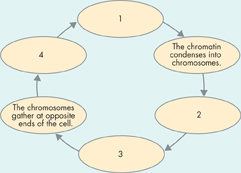10 Study Guide
 Growth, Development, and Reproduction
Growth, Development, and Reproduction
Cells undergo cell division to produce new cells. In eukaryotic cells, cell division is part of a highly regulated cycle known as the cell cycle.
10.1 Cell Growth, Division, and Reproduction
 The larger a cell becomes, the more demands the cell places on its DNA. In addition, a larger cell is less efficient in moving nutrients and waste materials across the cell membrane.
The larger a cell becomes, the more demands the cell places on its DNA. In addition, a larger cell is less efficient in moving nutrients and waste materials across the cell membrane.
 Asexual reproduction is the production of genetically identical offspring from a single parent.
Asexual reproduction is the production of genetically identical offspring from a single parent.
 Offspring produced by sexual reproduction inherit some of their genetic information from each parent.
Offspring produced by sexual reproduction inherit some of their genetic information from each parent.
10.2 The Process of Cell Division
 Chromosomes make it possible to separate DNA precisely during cell division.
Chromosomes make it possible to separate DNA precisely during cell division.
 During the cell cycle, a cell grows, prepares for division, and divides to form two daughter cells.
During the cell cycle, a cell grows, prepares for division, and divides to form two daughter cells.
 During prophase, the genetic material inside the nucleus condenses. During metaphase, the chromosomes line up across the center of the cell. During anaphase, the chromosomes separate and move along spindle fibers to opposite ends of the cell. During telophase, the chromosomes, which were distinct and condensed, begin to spread out into a tangle of chromatin.
During prophase, the genetic material inside the nucleus condenses. During metaphase, the chromosomes line up across the center of the cell. During anaphase, the chromosomes separate and move along spindle fibers to opposite ends of the cell. During telophase, the chromosomes, which were distinct and condensed, begin to spread out into a tangle of chromatin.
 Cytokinesis completes the process of cell division—it splits one cell into two.
Cytokinesis completes the process of cell division—it splits one cell into two.
chromosome (279)
centromere (282)
chromatin (280)
chromatid (282)
cell cycle (280)
centriole (282)
interphase (281)
metaphase (282)
mitosis (282)
anaphase (283)
cytokinesis (282)
telophase (283)
prophase (282)

10.3 Regulating the Cell Cycle
 The cell cycle is controlled by regulatory proteins both inside and outside the cell.
The cell cycle is controlled by regulatory proteins both inside and outside the cell.
 Cancer cells do not respond to the signals that regulate the growth of most cells. As a result, the cells divide uncontrollably.
Cancer cells do not respond to the signals that regulate the growth of most cells. As a result, the cells divide uncontrollably.
10.4 Cell Differentiation
 During the development of an organism, cells differentiate into many types of cells.
During the development of an organism, cells differentiate into many types of cells.
 The unspecialized cells from which differentiated cells develop are known as stem cells.
The unspecialized cells from which differentiated cells develop are known as stem cells.
 Stem cells offer the potential benefit of using undifferentiated cells to repair or replace badly damaged cells and tissues.
Stem cells offer the potential benefit of using undifferentiated cells to repair or replace badly damaged cells and tissues.
 Human embryonic stem cell research is controversial because the arguments for it and against it both involve ethical issues of life and death.
Human embryonic stem cell research is controversial because the arguments for it and against it both involve ethical issues of life and death.
embryo (292)
pluripotent (294)
differentiation (293)
stem cell (295)
totipotent (294)
multipotent (295)
blastocyst (294)
Think Visually Using the information in this chapter, complete the following cycle diagram of the cell cycle.
Table of Contents
- Formulas and Equations
- Applying Formulas and Equations
- Mean, Median, and Mode
- Estimation
- Using Measurements in Calculations
- Effects of Measurement Errors
- Accuracy
- Precision
- Comparing Accuracy and Precision
- Significant Figures
- Calculating With Significant Figures
- Scientific Notation
- Calculating With Scientific Notation
- Dimensional Analysis
- Applying Dimensional Analysis





